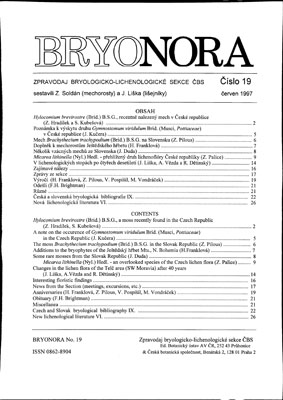

| Hradílek Z. & Kubešová S.: Hylocomium brevirostre (Brid.) B.S.G., recentně nalezený mech v České republice, 2–4 Hylocomium brevirostre (Brid.) B.S.G., a moss recently found in the Czech Republic Abstract: The moss Hylocomium breviroslre (Brid.) B.S.G.. regarded as extinct in the Czech Republic, was found at a new locality in southwestern Moravia (Ledové sluje near Vranov nad Dyjí) in 1994. Ecology of the species at the new locality and its chorology in the Czech Republic are discussed. The species should be included into the category endangered taxa instead of the category extinct taxa in the Red list of threatened bryophytes in the Czech Republic. |
| Kučera J.: Poznámka k výskytu druhu Gymnostomum viridulum Brid. (Musei, Pottiaceae) v České republice, 5–6 A note on the occurence of Gymnostomum viridulum Brid. (Musci, Pottiaceae) in the Czech Republic Abstract: Gymnostomum viridulum Brid. was recorded from the Czech Republic on the basis of the Bauer’s exsiccata from Kralupy n. Vlt. (central Bohemia), studied by Whitehouse and Crundwell in herbaria BM, E, GL and NMW. The author of the present paper failed to find the diacritical character (axillary or rhizoidal gemmae) in specimens of the same exsiccatum deposited in herbaria PR and PRC. The gemmae were not present even in other specimens collected at the same locality, and the identification of these species as G. viridulum is therefore regarded to be doubtful. Typical plants of the species with axillary gemmae were nevertheless found in material of Z. Hradilek from a single locality near Alexovice (S Moravia), so the occurence of G. viridulum in the Czech Republic has been confirmed. A brief history of the taxon and its short description are given |
| Pilous Z.: Mech Brachythecium trachypodium (Brid.) B.S.G. na Slovensku, 6–7 The moss Brachythecium trachypodium (Brid.) B.S.G. in the Slovak Republic Abstract: The subarctic-alpine moss species Brachythecium trachypodium (Brid.) B.S.G. was found in the High Tatra Mts. (Slovakia) in 1904 for the first time and since then has been considered as a very rare species here. The author of the present paper collected this species as well as other rare taxa of section Velutina De Not. Brachythecium velutinum (Hedw.) B.S.G. var. graniticum (Guemb.) Moenk. at several localities of the Belianské Tatry Mts. in the period 1952-1981 |
| Franklová H.: Doplněk k mechorostům Ještědského hřbetu, 7–8 Additions to the bryophytes of the Ještědský hřbet Mts., N. Bohemia Abstract: A short list of bryophytes of the Ještědský hřbet Mts. (N Bohemia) with additions to the previously published bryofloristic paper (Franklová 1995) is given |
| Duda J.: Několik vzácných mechů ze Slovenska, 8–9 Some rare mosses from the Slovak Republic Abstract: Four mosses collected by the author in the territory of Slovakia during 1951-1955 are evaluated as vanished (Hookeria lucens), rare (Metaneckera menziesii) and indeterminate (Anomodon rostratus and Barbula enderesii) in the second checklist of Slovak brvophytes (Kubinská et Janovicová 1996). |
| Palice Z.: Micarea lithinella (Nyl.) Hedl. - přehlížený druh lichenoflóry České republiky, 9–14 Micarea lithinella (Nyl.) Hedl. - an overlooked species of the Czech lichen flora Abstract: Specimens of a widely distributed, but less fequently collected microlichen species Micarea lithinella (Nyl.) Hedl. from the Czech Republic are discussed. Short description with notes on the ecology and distribution of the species are given. Specific ecological requirements of the species are also shortly discussed. Drawings of ascospores and conidiospores are presented and the species distribution in the Czech Republic based on the examined herbarium material is mapped. |
| Liška J., Vězda A. & Dětinský R.: V lichenologických stopách po čtyřech desetiletí, 14–16 Changes in the lichen flora of the Telč area (SW Moravia) after 40 years Abstract: A short excursion was made in the Telč area (SW Moravia) where a detailed floristical research was done by A.Vězda about 40 years ago. Many changes oflichen flora were found recently. At presnt epiphytic lichen flora is very poor and many species disappeared. Also many epipetric lichens vanished (namely ferrophilous species). The main causes of the changes mentioned are destruction of habitats (using boulders as building material) and change in landscape management together with succession and air pollution |
| Anonymus: Zajímavé nálezy, 16–17 Interesting floristic findings |
| Soldán Z. & Vacínová I.: Zprávy ze sekce , 17–18 News from the Section (meetings, excursions, etc.) |
| Duda J. & Novotný I.: Výročí (H. Franklová, Z. Pilous, V. Pospíšil, M. Vondráček), 19–21 Anniversaries (H. Franklová, Z. Pilous, V. Pospíšil, M. Vondráček) |
| Anonymus: Odešli (F.H. Brightman), 21–21 Obituary (F.H. Brightman) |
| Anonymus: Různé, 21–22 Miscellanea |
| Soldán Z.: Česká a slovenská bryologická bibliografie IX., 22–26 Czech and Slovak bryological bibliography IX. |
| Liška J.: Nová lichenologická literatura VI., 26–28 New lichenological literature VI. |